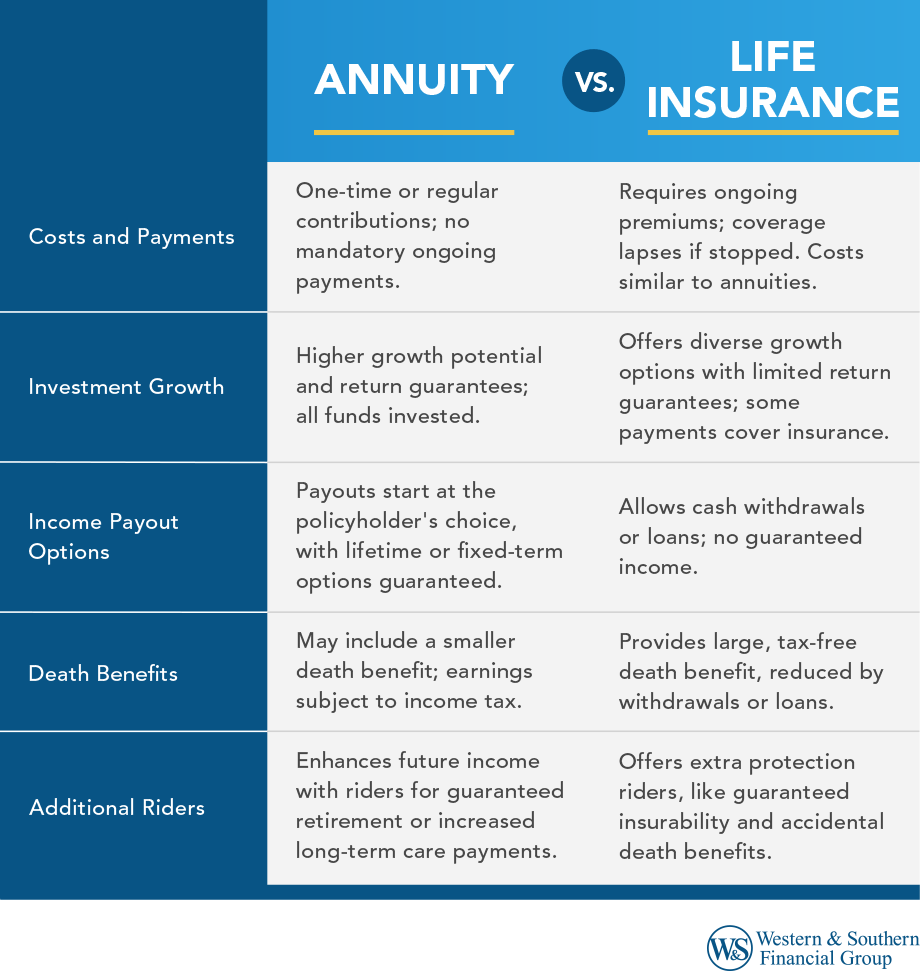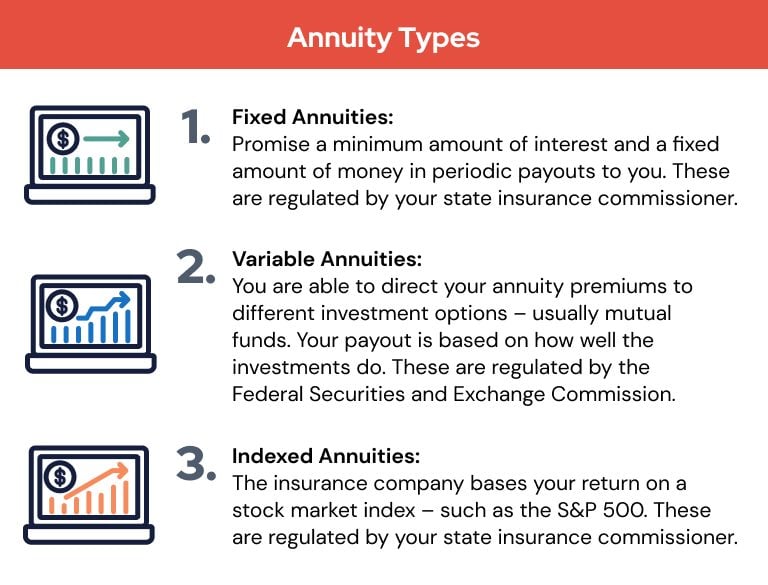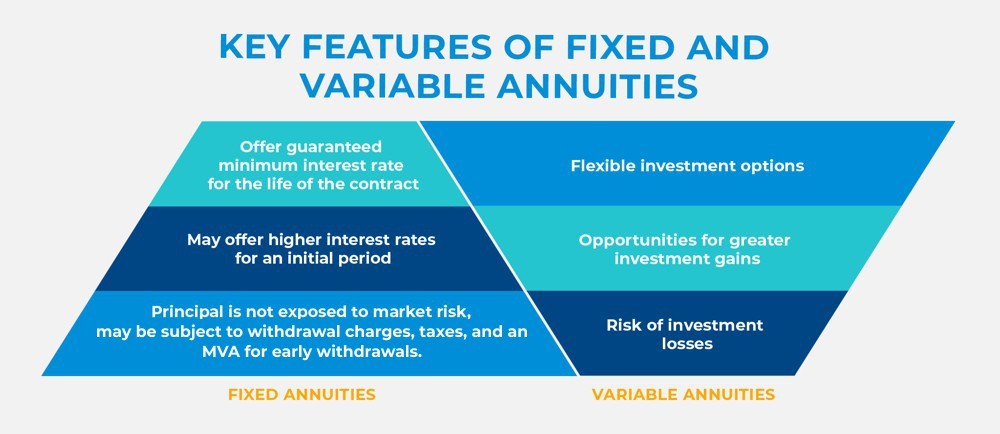Featured
Table of Contents
Equally as with a taken care of annuity, the owner of a variable annuity pays an insurance provider a round figure or series of settlements in exchange for the promise of a collection of future settlements in return. However as mentioned over, while a dealt with annuity expands at an assured, constant price, a variable annuity expands at a variable price that depends upon the efficiency of the underlying investments, called sub-accounts.

Throughout the build-up stage, possessions purchased variable annuity sub-accounts expand on a tax-deferred basis and are exhausted only when the contract proprietor takes out those revenues from the account. After the build-up phase comes the income phase. Over time, variable annuity assets ought to theoretically enhance in worth up until the agreement owner chooses he or she would like to start taking out money from the account.
The most significant concern that variable annuities usually existing is high price. Variable annuities have numerous layers of charges and expenses that can, in accumulation, develop a drag of up to 3-4% of the contract's value yearly. Below are the most common charges related to variable annuities. This expenditure makes up the insurance company for the risk that it assumes under the terms of the contract.
Breaking Down Fixed Vs Variable Annuity Everything You Need to Know About Fixed Annuity Or Variable Annuity Defining Fixed Interest Annuity Vs Variable Investment Annuity Pros and Cons of Various Financial Options Why Choosing the Right Financial Strategy Matters for Retirement Planning How to Compare Different Investment Plans: Explained in Detail Key Differences Between Fixed Vs Variable Annuity Pros Cons Understanding the Key Features of Long-Term Investments Who Should Consider Strategic Financial Planning? Tips for Choosing the Best Investment Strategy FAQs About Fixed Annuity Vs Variable Annuity Common Mistakes to Avoid When Planning Your Retirement Financial Planning Simplified: Understanding Your Options A Beginner’s Guide to Smart Investment Decisions A Closer Look at How to Build a Retirement Plan
M&E expenditure charges are determined as a portion of the contract value Annuity companies hand down recordkeeping and other administrative expenses to the contract proprietor. This can be in the form of a flat yearly charge or a portion of the agreement worth. Management fees may be consisted of as component of the M&E threat fee or may be examined separately.
These charges can vary from 0.1% for easy funds to 1.5% or more for actively managed funds. Annuity agreements can be customized in a variety of ways to serve the details needs of the agreement proprietor. Some typical variable annuity riders consist of guaranteed minimum buildup benefit (GMAB), assured minimum withdrawal advantage (GMWB), and ensured minimum earnings benefit (GMIB).

Variable annuity contributions give no such tax obligation deduction. Variable annuities tend to be extremely ineffective vehicles for passing riches to the future generation since they do not enjoy a cost-basis change when the original agreement owner passes away. When the proprietor of a taxable investment account dies, the cost bases of the financial investments held in the account are gotten used to mirror the market prices of those financial investments at the time of the owner's death.
Decoding How Investment Plans Work A Closer Look at Fixed Income Annuity Vs Variable Growth Annuity Defining the Right Financial Strategy Features of Smart Investment Choices Why Choosing the Right Financial Strategy Can Impact Your Future Variable Vs Fixed Annuity: Simplified Key Differences Between Different Financial Strategies Understanding the Risks of Fixed Index Annuity Vs Variable Annuity Who Should Consider Strategic Financial Planning? Tips for Choosing Fixed Annuity Vs Equity-linked Variable Annuity FAQs About Planning Your Financial Future Common Mistakes to Avoid When Planning Your Retirement Financial Planning Simplified: Understanding Variable Annuity Vs Fixed Indexed Annuity A Beginner’s Guide to Indexed Annuity Vs Fixed Annuity A Closer Look at What Is A Variable Annuity Vs A Fixed Annuity
Consequently, successors can inherit a taxable investment profile with a "fresh start" from a tax viewpoint. Such is not the situation with variable annuities. Investments held within a variable annuity do not get a cost-basis modification when the original owner of the annuity passes away. This implies that any kind of gathered latent gains will be handed down to the annuity proprietor's beneficiaries, in addition to the associated tax burden.
One significant concern related to variable annuities is the possibility for conflicts of passion that may feed on the component of annuity salesmen. Unlike a monetary advisor, who has a fiduciary responsibility to make financial investment decisions that profit the client, an insurance policy broker has no such fiduciary responsibility. Annuity sales are extremely profitable for the insurance policy specialists who market them due to high upfront sales payments.

Several variable annuity agreements have language which positions a cap on the percent of gain that can be experienced by certain sub-accounts. These caps stop the annuity proprietor from totally taking part in a part of gains that can otherwise be appreciated in years in which markets create significant returns. From an outsider's perspective, presumably that capitalists are trading a cap on financial investment returns for the previously mentioned ensured flooring on investment returns.
As kept in mind above, surrender charges can badly restrict an annuity proprietor's capability to move properties out of an annuity in the very early years of the agreement. Better, while a lot of variable annuities permit contract owners to take out a defined amount during the buildup phase, withdrawals yet amount usually cause a company-imposed cost.
Withdrawals made from a fixed rate of interest investment alternative can likewise experience a "market worth change" or MVA. An MVA adjusts the worth of the withdrawal to reflect any kind of modifications in rate of interest from the moment that the cash was purchased the fixed-rate alternative to the time that it was taken out.

On a regular basis, even the salespeople who sell them do not fully understand exactly how they function, therefore salespeople in some cases prey on a buyer's emotions to market variable annuities instead than the advantages and suitability of the products themselves. Our company believe that financiers ought to totally comprehend what they have and how much they are paying to own it.
Understanding Financial Strategies Everything You Need to Know About Annuity Fixed Vs Variable What Is Variable Vs Fixed Annuities? Pros and Cons of Tax Benefits Of Fixed Vs Variable Annuities Why Choosing the Right Financial Strategy Can Impact Your Future Fixed Income Annuity Vs Variable Growth Annuity: A Complete Overview Key Differences Between Annuities Fixed Vs Variable Understanding the Key Features of Long-Term Investments Who Should Consider Strategic Financial Planning? Tips for Choosing the Best Investment Strategy FAQs About Variable Vs Fixed Annuities Common Mistakes to Avoid When Planning Your Retirement Financial Planning Simplified: Understanding Your Options A Beginner’s Guide to Smart Investment Decisions A Closer Look at Immediate Fixed Annuity Vs Variable Annuity
However, the very same can not be claimed for variable annuity properties kept in fixed-rate investments. These properties legitimately belong to the insurer and would as a result go to risk if the firm were to fall short. Likewise, any type of assurances that the insurance provider has actually accepted provide, such as a guaranteed minimum income advantage, would certainly remain in concern in the occasion of a company failing.
For that reason, prospective purchasers of variable annuities need to comprehend and consider the monetary problem of the providing insurer before participating in an annuity contract. While the advantages and drawbacks of various sorts of annuities can be disputed, the real issue bordering annuities is that of suitability. Simply put, the inquiry is: who should have a variable annuity? This inquiry can be tough to answer, given the myriad variations available in the variable annuity world, yet there are some standard standards that can aid financiers decide whether or not annuities must play a duty in their monetary plans.
As the stating goes: "Customer beware!" This post is prepared by Pekin Hardy Strauss, Inc. Comparing fixed vs variable annuities. ("Pekin Hardy," dba Pekin Hardy Strauss Wide Range Management) for informational functions only and is not planned as a deal or solicitation for service. The details and information in this article does not constitute lawful, tax obligation, accounting, financial investment, or various other specialist suggestions
Table of Contents
Latest Posts
Analyzing Strategic Retirement Planning Key Insights on Your Financial Future What Is the Best Retirement Option? Benefits of Choosing the Right Financial Plan Why Indexed Annuity Vs Fixed Annuity Is
Analyzing Strategic Retirement Planning A Comprehensive Guide to Investment Choices What Is Variable Annuity Vs Fixed Indexed Annuity? Pros and Cons of Fixed Index Annuity Vs Variable Annuity Why Choo
Understanding Financial Strategies Key Insights on Your Financial Future Defining Fixed Index Annuity Vs Variable Annuity Features of Smart Investment Choices Why Choosing the Right Financial Strategy
More
Latest Posts